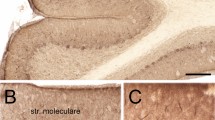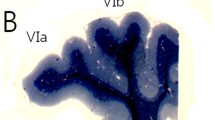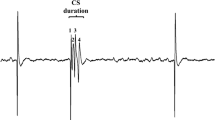Summary
The number and freeze-fracture membrane organization of spines on Purkinje cell dendrites were studied in rats after destruction, by intraperitoneal injection of 3-acetyl-pyridine (3-AP), of the climbing fiber afferents to the cerebellum. The results obtained show that: (1) there is a 1.6 fold increase in the total number of dendritic spines in the 3-AP-treated animals as compared to controls, but no change in the total number of spine synaptic profiles; (2) the spines from main dendrites in both control and 3-AP-treated animals have more than 1,000 IMP/μm2 of P-face membrane; and, (3) the spines formed on Purkinje cell dendrites in the absence of their presynaptic axons have the same P-face membrane organization (i.e. more than 1,000 IMP/μm2) as spines normally innervated by afferent climbing fibers. These data suggest that each type of Purkinje cell spine has a specific P-face membrane organization which does not appear to be influenced by presynaptic terminals.
Similar content being viewed by others
References
Altman J (1972) Postnatal development of the cerebellar cortex in the rat. II. Phases in the maturation of Purkinje cells and of the molecular layer. J Comp Neurol 145: 199–245
Batini C, Corvisier J, Destombes J, Gioanni H, Everett J (1976) The climbing fibers of the cerebellar cortex, their origin and pathway in the cat. Exp Brain Res 26: 407–422
Bradley P, Berry M (1976) Quantitative effects of climbing fiber deafferentiation on the adult Purkinje cell dendritic tree. Brain Res 112: 133–140
Brown D (1981) Polyvinyl alcohol coating: an improvement of the freeze-fracture technique. J Microsc 21: 283–287
Crepel F (1971) Maturation of climbing fiber responses in the rat. Brain Res 35: 272–276
Denk H, Haider M, Koyac W, Studynka G (1968) Verhaltensänderung und Neuropathologie bei der 3-Acetyl-pyridin-Vergiftung der Ratte. Acta Neuropath (Berl) 10: 34–44
Desclin JC (1974) Histological evidence supporting the inferior olive as the major source of cerebellar climbing fibers in the rat. Brain Res 77: 365–384
Desclin JC (1976) Early terminal degeneration of cerebellar climbing fibers after destruction of the inferior olive in the rat. Synaptic relationships in the molecular layer. Anat Embryol (Berl) 149: 87–112
Desclin JC, Escubi J (1974) Effects of 3-acetylpyridine on the central nervous system of the rat, as demonstrated by silver methods. Brain Res 77: 349–364
Desclin JC, Colin F (1980) The olivocerebellar system. II. Some ultrastructural correlates of inferior olive destruction in the rat. Brain Res 187: 29–46
Eccles JC (1977) An instruction-selection theory of learning in the cerebellar cortex. Brain Res 127: 327–352
Garcia-Segura LM, Perrelet A (1981) Freeze-fracture of developing neuronal plasma membrane in postnatal cerebellum. Brain Res 208: 19–33
Garcia-Segura LM, Perrelet A (1982) Climbing fiber destruction affects dendrite and spine membrane organization in Purkinje cells. Brain Res 236: 253–260
Groenewegen HJ, Voogd J (1977) The parasagittal zonation within the olivocerebellar projection. I. Climbing fiber distribution in the vermis of the cat cerebellum. J Comp Neurol 1974: 417–488
Hay ED, Hasty DL (1979) Extrusion of particle-free membrane blisters during glutaraldehyde fixation. In: Rash JE, Hudson CS (eds) Freeze-fracture: methods, artifacts and interpretations. Raven Press, New York, pp 59–66
Hoffer BJ, Bloom FE, Siggins GR, Woodward DJ (1972) The development of synapses in the rat cerebellar cortex. In: Clemente DC, Purpura DP, Mayer FE (eds) Sleep and the maturing nervous system. Academic Press, New York, pp 33–39
Larramendi LMH, Victor T (1967) Synapses on the Purkinje cell spines in the mouse. An electron microscopic study. Brain Res 5: 15–30
Llinás R, Walton K, Hillman DE, Sotelo C (1975) Inferior olive: its role in motor learning. Science 190: 1230–1231
Luft JH (1961) Improvements in epoxy resin embedding methods. J Biophys Biochem Cytol 9: 409–414
McIntyre JA, Gilula NB, Karnovsky MJ (1974) Cryoprotectant-induced redistribution of intramembranous particles in mouse lymphocytes. J Cell Biol 60: 192–202
Millonig G (1961) Advantages of a phosphate buffer for OsO4 solutions in fixation. J Appl Physics 32: 1637
Montarolo PG, Raschi F, Strata P (1980) On the origin of the climbing fibers of the cerebellar cortex. Pflügers Arch 383: 137–142
Moor H, Mühlethaler K (1963) Fine structure in frozen-etched yeast cells. J Cell Biol 17: 609–628
Nicholson JL, Altman J (1972) The effects of early hypo- and hyperthyroidism in the development of the rat cerebellar cortex. II. Synaptogenesis in the molecular layer. Brain Res 44: 25–36
Palay SL, Chan-Palay V (1974) Cerebellar cortex: Cytology and organization. Springer, New York
Pfenninger KH, Bunge RP (1974) Freeze-fracturing of nerve growth cones and young fibers. A study of developing plasma membrane. J Cell Biol 63: 180–196
Rebiere A (1973) Aspects quantitatifs de la synaptogenèse dans le cervelet du rat sous-alimenté dès la naissance. Comparaison avec l'animal rendu hypothyroïdien. C R Acad Sci Ser D 276D: 2317–2320
Robain O, Bideau I, Farkas E (1981) Developmental changes of synapses in the cerebellar cortex of the rat. A quantitative analysis. Brain Res 206: 1–8
Simantov R, Snyder SH, Oster-Granite ML (1976) Harmalineinduced tremor in the rat: abolition by 3-acetyl-pyridine destruction of cerebellar climbing fibers. Brain Res 114: 144–151
Sotelo C, Hillmann DE, Zamora AJ, Llinás R (1975) Climbing fiber deafferentiation: Its action on Purkinje cell dendritic spines. Brain Res 98: 574–581
Sotelo C, Arsenio-Nunes ML (1976) Development of Purkinje cells in absence of climbing fibers. Brain Res 111: 389–395
Sotelo C (1978) Purkinje cell ontogeny: formation and maintenance of spines. Prog Brain Res 48: 149–170
Szentágothai J, Rajkovits U (1959) Über den Ursprung der Kletterfasern des Kleinhirns. Z Anat Entwicklungsgesch 121: 130–141
Author information
Authors and Affiliations
Additional information
Supported by the Swiss National Science Foundation, Grant 3.668.80
Rights and permissions
About this article
Cite this article
Baetens, D., Garcia-Segura, L.M. & Perrelet, A. Effects of climbing fiber destruction on large dendrite spines of purkinje cells. Exp Brain Res 48, 256–262 (1982). https://doi.org/10.1007/BF00237221
Received:
Issue Date:
DOI: https://doi.org/10.1007/BF00237221




